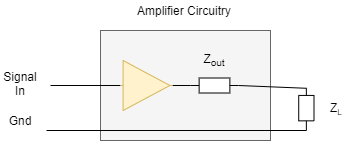If you've ever made audio circuits where the output isn't as loud as you expected, its probably because the impedances were not matched. In this post, let's explore the key idea and what you need to know about Impedance matching. If you don't know, what 'impedance' is, I highly recommend reading this.



Yes, the output impedance of the amplifier (Zout) forms a voltage divider with the speaker's impedance (ZL ). The letter L simply denotes that the speaker is our 'load'. Now, for the speaker to be as loud as possible, it should receive maximum power(PL) which is given by-
Is 137mW the maximum power that this circuit can provide?
As a pre-requisite, you must also know what a voltage divider is. Here's a quick example. You can skip this section if you already know what a voltage divider is.


A voltage divider is nothing more than two resistors/impedances in series, with the output taken between R2 and ground. In this simple circuit, Vout is given by-
This is quite useful, as by varying values of R1 and R2 you can vary the output voltage. For instance, if R1 and R2 have the same value, say 1k ohms Vout will be half of Vin. In fact, this is also how a potentiometer works.
Impedance Matching
Generally, impedance matching is used in two contexts-
1. An amplifier connected to a speaker
2. Between stages of a multistage amplifier
1. An amplifier connected to a speaker
Here a block diagram of an amplifier connected to a speaker-

Zout is the output impedance of the amplifier circuit. If this doesn't ring any bells, this should-
PL = IL x VL
Where IL is the current flowing through the speaker and VL is the voltage across the speaker, which can be found using the voltage divider rule.
Lets put in some realistic numbers-
Suppose the voltage from the amplifier, Vamp= 10V. And the remaining components have values as shown in the picture above.
How much power does the speaker receive?
First, find VL,
You could try doing the same calculation for a few different values of ZL. You'll notice that the maximum power will be obtained when ZL=Zout. More specifically, in this case, when ZL=16 ohms. This could be done by using either a 16-ohm speaker or by reducing the output impedance of the amplifier to 8 ohms.
This is known as impedance matching. In real life, you won't change the speaker to match your circuit, instead, you would tweak a few resistors in the amplifier to lower its output impedance.
2. Between stages of a multistage amplifier
In most guitar pedals you come across, there is usually more than one amplifier stage using transistors or opamps. In contrast to the previous case, we don't need to worry about power. What we need to focus on is ensuring that the voltage from one stage is transferred completely to the next.
In the ideal case, we generally assume that the amplified signal (voltage, not current!) from one stage is completely received by the next. However, in reality, the output impedance of the first amplifier (Z1out) and the input impedance of the second amplifier form a voltage divider (Z2in). So, only a part of the signal is received by the second stage.
To avoid this problem, while designing the circuit, always try to make sure, that the input impedance of the amplifier is as high as possible, and the output impedance is as low as possible.
By doing this, maximum voltage drops across the input of the next stage.
Buffer circuits, such as the common collector amplifier (using a BJT) are used to fix this impedance matching problem between stages without amplifying the voltage. I'll discuss this topic in greater detail in the next article!
I hope this small reading helped you understand impedance matching and its importance better. If there's anything you'd like to ask or share, please do leave a comment below!
Cheers,
Siddharth







Comments
Post a Comment